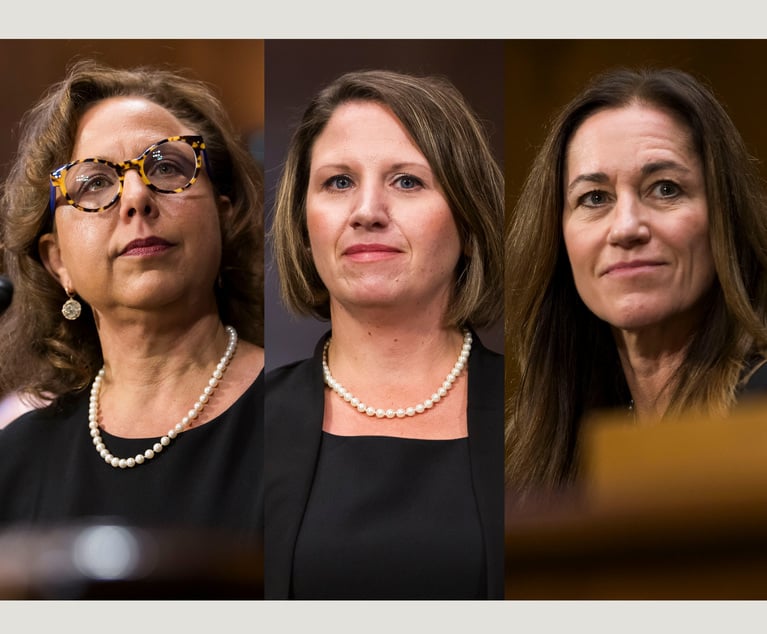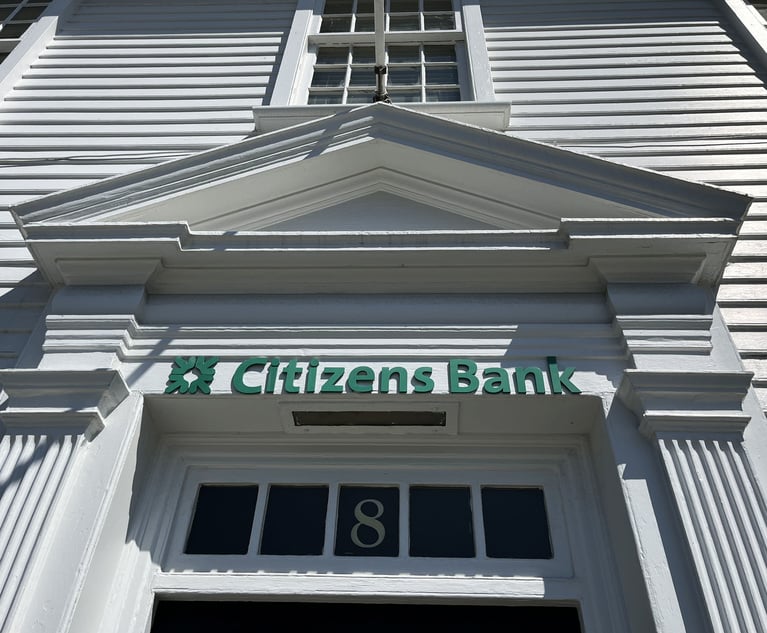Pharmaceutical Patent Term Extensions and Patent Term Adjustments: Choose Wisely
For pharmaceutical inventions, which usually undergo a lengthy FDA approval process before any drug can be sold, the most valuable portion of patent term is at the end of the patent's life, after FDA approval.
March 29, 2019 at 01:17 PM
9 minute read
 Matthew Pearson, Angela Verrecchio and Jason Weil of Akin Gump Strauss Hauer & Feld.
Matthew Pearson, Angela Verrecchio and Jason Weil of Akin Gump Strauss Hauer & Feld.
A patent's term defines the length of time the patent holder may exclude others from using the invention. For pharmaceutical inventions, which usually undergo a lengthy FDA approval process before any drug can be sold, the most valuable portion of patent term is at the end of the patent's life, after FDA approval. Patent owners understandably want to maximize their patent's life and competitors want the patent to expire as soon as possible.
One way for competitors to try to shorten a patent's term during litigation is to allege that an asserted patent is invalid because of obviousness-type double patenting (OTDP). OTDP is a judicial doctrine that prevents a patentee from obtaining multiple patents with claims that are obvious variants of one another, but have different expiration dates. The doctrine prohibits an inventor from extending her right to exclude others from using the invention with claims in a later-expiring patent that are not patentably distinct from claims in her earlier-expiring patent. Faced with such a challenge, the patentee can disclaim the term after the earlier expiration date (with a terminal disclaimer). The end result of a challenge will be to limit the term to the earlier expiration date.
But there are other statutory provisions that allow the U.S. Patent and Trademark Office (PTO) to adjust or extend a patent's term, sometimes by the choice of the patentee. Recent case law suggests a new factor patentees should consider when making such choices—patentees might not want to seek an extension of a patent's term if its term has already been otherwise adjusted.
Currently, the term for a U.S. patent is 20 years from the filing date of the earliest-filed nonprovisional application in the family of the patent at issue. But the PTO can adjust a patent's term pursuant to 35 U.S.C. Section 154 because of PTO delays during prosecution. That adjustment is called patent term adjustment, or PTA. Thus, if PTO delays prevented a patentee from enjoying the full patent term of his patent, and if the requirements of Section 154 are met, the patentee can get some of that lost time back. PTA is calculated at the end of patent prosecution, before a patent issues, and is identified on the face of the patent as a number of days that are added to the patent's term.
The PTO can also, pursuant to 35 U.S.C. Section 156 and in coordination with the FDA, extend the term of a patent covering a pharmaceutical product because of delays in the FDA's review process for that product. This is called patent term extension, or PTE. PTE is intended to extend a patent's term where the term has already been running, but the patent holder could not sell its covered product because of delays in the FDA approval process. Such an extension is limited to a single patent, selected by the patentee, covering the pharmaceutical product, and the patent's term can only be extended for up to five years and not beyond a date that is 14 years after FDA approval. If granted, pursuant to Section 156(a), such PTE is applied in addition to any PTA (“the term of a patent which claims a product … shall be extended in accordance with this section from the original expiration date of the patent, which shall include any patent term adjustment granted under section 154(b) …”), and a patent's term is extended by a number of days attributable to FDA delay (minus any days of PTA the patent already benefits from).
Patents in the same family often share the same disclosure and cover similar inventions. For example, an inventor often files a parent application claiming a broad class of compounds and continuation applications claiming narrower inventions. Such continuation applications are often subject to OTDP rejections based on the parent patent. In those situations, an inventor can disclaim part of the term of any patent issuing from the application, ensuring its term does not extend beyond the term of the parent patent. If none of the patents in the family had been extended by PTA or PTE, they likely have the same expiration dates.
But, extension of patent term via PTA and PTE can result in different expiration dates for patents, even within the same family. Recent cases have addressed the interplay of PTA/PTE and OTDP with mixed results. On the one hand, in Merck & Co. v. Hi-Tech Pharmacal, 482 F.3d 1317 (Fed. Cir. 2007), the U.S. Court of Appeals for the Federal Circuit affirmed the district court's decision holding that a patent challenged in litigation was not proven invalid for OTDP, even though the patent's term had been terminally disclaimed during prosecution and then extended via PTE past the reference patent's expiration date. On the other hand, at least one district court has found that an earlier-expiring patent in the same family can be used as an OTDP reference against a family member that expired later due to PTA, as in Magna Electronics v. TRW Auto Holdings, No. 1:12-cv-654; 1:13-cv-324 (W.D. Mich. Dec. 10, 2015). The Magna case settled after the district court decision so the Federal Circuit did not review it.
Recently, in Novartis AG v. Ezra Ventures, 909 F.3d 1367 (Fed. Cir. 2018), the Federal Circuit held for the first time that OTDP does not invalidate validly obtained PTE, if the unextended patent would have been otherwise valid.
Ezra filed an application seeking approval to market a generic version of Novartis's drug Gilenya®. Novartis sued Ezra for infringement of U.S. Patent No. 5,604,229 (the 229 Patent), which covered the compound used in Gilenya®. The 229 Patent's original term had been set to expire on Feb. 18, 2014, but, due to regulatory delays in the approval of Gilenya®, the 229 Patent received five years of PTE pursuant to Section 156, extending it until Feb. 18.
Ezra alleged that the 229 Patent was invalid for OTDP over a second Novartis patent that was filed after, but expired before, the 229 Patent. The court relied heavily on its decision in Merck in which it stressed the fact that §156 says a patent's term “shall” be extended, making it permissible to file a terminal disclaimer to overcome a OTDP rejection, but to then recapture patent term lost due to FDA delay. This is in contrast to recapturing patent term via PTA pursuant to Section 154, which cannot be used to extend patent term beyond any terminal disclaimer. See Section 154(b)(2)(B) (“No patent the term of which has been disclaimed beyond a specified date may be adjusted under this section beyond the expiration date specified in the disclaimer.”). Ultimately, the Federal Circuit explained that, where a patent, pursuant to its pre-PTE expiration date, is valid under all provisions of law, it is entitled to the full term of its PTE. Because the unextended 229 Patent would have expired before the OTDP reference, the 229 Patent was not susceptible to an OTDP challenge and enjoyed its full PTE.
These cases help shape the legal landscape relating to the interplay of PTA/PTE and OTDP law. A patent that expires before or at the same time as another patent is not subject to an OTDP challenge based on the second patent. The Ezra case explains that such patents are entitled to their full PTE, and are not susceptible to OTDP challenges even if the PTE results in an expiration date after the second patent. In contrast, the district court's opinion in Magna suggests that patents extended only by PTA are still susceptible to an OTDP challenge.
The Ezra case did not answer the question of whether a patent that receives PTA, and then is subsequently further extended via PTE, would be subject to an OTDP challenge. In such a situation, the pre-PTE term of the patent will have already been extended by PTA. Under Magna, that PTA extension would leave the patent potentially vulnerable to an OTDP challenge based on an earlier expiring patent. Does such a patent have “PTE pursuant to [Section 156 that] is valid so long as the extended patent is otherwise valid without the extension” as described in the Ezra holding?
In light of this uncertainty, innovators seeking to protect a new drug product should carefully select the patent for which they seek PTE. Because the number of days of PTE awarded depends on the number of days of PTA the patent already has, applying PTE to a patent that does not have any PTA might still result in a term extension to the same date as another patent that already has some PTA—i.e., one patent might receive more “days” of PTE, but that might not change the ultimate potential length of patent protection. A patent only extended by PTE, however, should fall squarely within Ezra, and eliminate the uncertainty surrounding a patent having both PTA and PTE. Accordingly, if a patent owner has more than one patent that sufficiently covers its product, it should consider seeking PTE for a patent that does not already have PTA due to PTO delay.
Matthew A. Pearson, a partner at Akin Gump Strauss Hauer & Feld, concentrates his practice on intellectual property and patent litigation.
Angela Verrecchio, senior counsel at the firm, focuses her intellectual property practice on life sciences patent litigation.
Jason Weil, counsel at the firm, practices law in the area of intellectual property, with a focus on patent litigation.
This content has been archived. It is available through our partners, LexisNexis® and Bloomberg Law.
To view this content, please continue to their sites.
Not a Lexis Subscriber?
Subscribe Now
Not a Bloomberg Law Subscriber?
Subscribe Now
NOT FOR REPRINT
© 2025 ALM Global, LLC, All Rights Reserved. Request academic re-use from www.copyright.com. All other uses, submit a request to [email protected]. For more information visit Asset & Logo Licensing.
You Might Like
View All
Pa. Federal District Courts Reach Full Complement Following Latest Confirmation

The Defense Bar Is Feeling the Strain: Busy Med Mal Trial Schedules Might Be Phila.'s 'New Normal'
7 minute read
Federal Judge Allows Elderly Woman's Consumer Protection Suit to Proceed Against Citizens Bank
5 minute read
Judge Leaves Statute of Limitations Question in Injury Crash Suit for a Jury
4 minute readTrending Stories
- 1New York-Based Skadden Team Joins White & Case Group in Mexico City for Citigroup Demerger
- 2No Two Wildfires Alike: Lawyers Take Different Legal Strategies in California
- 3Poop-Themed Dog Toy OK as Parody, but Still Tarnished Jack Daniel’s Brand, Court Says
- 4Meet the New President of NY's Association of Trial Court Jurists
- 5Lawyers' Phones Are Ringing: What Should Employers Do If ICE Raids Their Business?
Who Got The Work
J. Brugh Lower of Gibbons has entered an appearance for industrial equipment supplier Devco Corporation in a pending trademark infringement lawsuit. The suit, accusing the defendant of selling knock-off Graco products, was filed Dec. 18 in New Jersey District Court by Rivkin Radler on behalf of Graco Inc. and Graco Minnesota. The case, assigned to U.S. District Judge Zahid N. Quraishi, is 3:24-cv-11294, Graco Inc. et al v. Devco Corporation.
Who Got The Work
Rebecca Maller-Stein and Kent A. Yalowitz of Arnold & Porter Kaye Scholer have entered their appearances for Hanaco Venture Capital and its executives, Lior Prosor and David Frankel, in a pending securities lawsuit. The action, filed on Dec. 24 in New York Southern District Court by Zell, Aron & Co. on behalf of Goldeneye Advisors, accuses the defendants of negligently and fraudulently managing the plaintiff's $1 million investment. The case, assigned to U.S. District Judge Vernon S. Broderick, is 1:24-cv-09918, Goldeneye Advisors, LLC v. Hanaco Venture Capital, Ltd. et al.
Who Got The Work
Attorneys from A&O Shearman has stepped in as defense counsel for Toronto-Dominion Bank and other defendants in a pending securities class action. The suit, filed Dec. 11 in New York Southern District Court by Bleichmar Fonti & Auld, accuses the defendants of concealing the bank's 'pervasive' deficiencies in regards to its compliance with the Bank Secrecy Act and the quality of its anti-money laundering controls. The case, assigned to U.S. District Judge Arun Subramanian, is 1:24-cv-09445, Gonzalez v. The Toronto-Dominion Bank et al.
Who Got The Work
Crown Castle International, a Pennsylvania company providing shared communications infrastructure, has turned to Luke D. Wolf of Gordon Rees Scully Mansukhani to fend off a pending breach-of-contract lawsuit. The court action, filed Nov. 25 in Michigan Eastern District Court by Hooper Hathaway PC on behalf of The Town Residences LLC, accuses Crown Castle of failing to transfer approximately $30,000 in utility payments from T-Mobile in breach of a roof-top lease and assignment agreement. The case, assigned to U.S. District Judge Susan K. Declercq, is 2:24-cv-13131, The Town Residences LLC v. T-Mobile US, Inc. et al.
Who Got The Work
Wilfred P. Coronato and Daniel M. Schwartz of McCarter & English have stepped in as defense counsel to Electrolux Home Products Inc. in a pending product liability lawsuit. The court action, filed Nov. 26 in New York Eastern District Court by Poulos Lopiccolo PC and Nagel Rice LLP on behalf of David Stern, alleges that the defendant's refrigerators’ drawers and shelving repeatedly break and fall apart within months after purchase. The case, assigned to U.S. District Judge Joan M. Azrack, is 2:24-cv-08204, Stern v. Electrolux Home Products, Inc.
Featured Firms
Law Offices of Gary Martin Hays & Associates, P.C.
(470) 294-1674
Law Offices of Mark E. Salomone
(857) 444-6468
Smith & Hassler
(713) 739-1250





